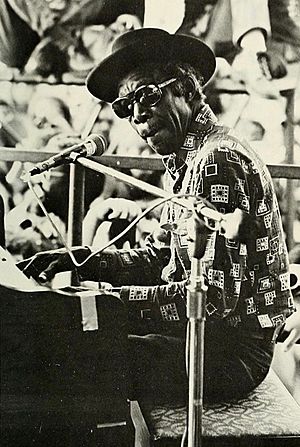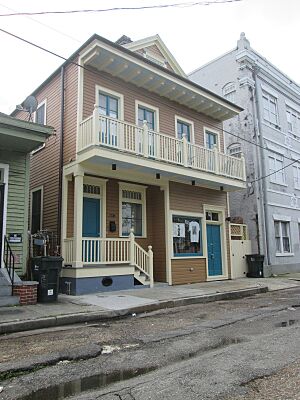Professor Longhair facts for kids
Quick facts for kids
Professor Longhair
|
|
|---|---|

Professor Longhair at 1975 New Orleans Jazz & Heritage Festival
|
|
| Background information | |
| Birth name | Henry Roeland Byrd |
| Also known as | Fess |
| Born | December 19, 1918 Bogalusa, Louisiana, U.S. |
| Origin | New Orleans, Louisiana, U.S. |
| Died | January 30, 1980 (aged 61) New Orleans, Louisiana, U.S. |
| Genres |
|
| Occupation(s) | Musician |
| Instruments | Vocals, piano |
| Years active | 1948–1980 |
Henry Roeland Byrd (born December 19, 1918 – died January 30, 1980) was a famous American musician. He was better known by his stage name, Professor Longhair, or simply "Fess." He was a talented singer and pianist.
Professor Longhair played a special kind of music called New Orleans blues. His piano style was very unique. It mixed sounds from rhumba, mambo, and calypso. People could recognize his music right away!
He was very important to the music scene in New Orleans. Many other famous musicians looked up to him. These included Fats Domino, Allen Toussaint, and Dr. John.
Contents
His Life and Music
Henry Byrd was born in Bogalusa, Louisiana, on December 19, 1918. He learned to play piano on an instrument that was missing some keys. This helped him create his very special style.
He started his music career in New Orleans in 1948. A club owner named Mike Tessitore gave him the stage name "Professor Longhair." In 1949, he recorded his first songs with a band called the Shuffling Hungarians. One of these was "Mardi Gras in New Orleans," which became a famous song.
Professor Longhair had one national hit song called "Bald Head" in 1950. He also recorded other popular songs like "Tipitina" and "Go to the Mardi Gras". Even though he didn't have many big hits, other musicians saw him as a huge influence.
In the 1960s, Professor Longhair's music career slowed down. He worked as a janitor to earn money.
A Comeback Story
After some quiet years, Professor Longhair's music career made a big comeback. He was invited to play at the New Orleans Jazz & Heritage Festival in 1971. He also performed at other big festivals, like the Newport Jazz Festival in 1973.
His album The London Concert showed his music from a trip to the United Kingdom. Another important album was Professor Longhair – Live on the Queen Mary. This was recorded in 1975 during a party hosted by Paul McCartney and Linda McCartney.
By the 1980s, his albums like Crawfish Fiesta were easy to find. He also appeared on TV shows and in a film called Piano Players Rarely Ever Play Together. This film showed him and other great pianists.
Professor Longhair sadly passed away in his sleep from a heart attack on January 30, 1980. This happened while the film about him was still being made. He was buried in New Orleans. His manager, Allison Miner, was very dedicated to him. She helped him have the best years of his music career.
Awards and Honors
Professor Longhair received many honors for his amazing music.
- In 1981, he was added to the Blues Hall of Fame.
- In 1987, he won a Grammy Award after he passed away. This was for a collection of his recordings.
- In 1992, he was inducted into the Rock and Roll Hall of Fame.
- In 2016, he was added to the Louisiana Music Hall Of Fame. This ceremony took place at his old home in New Orleans.
Professor Longhair in Pop Culture
Professor Longhair's music is still loved today.
- The song "Tipitina" was covered by actor and musician Hugh Laurie in 2011. Hugh Laurie is a big fan of Professor Longhair. He even used "Go to the Mardi Gras" as a theme song for one of his TV shows.
- The famous New Orleans music club Tipitina's is named after his song "Tipitina." The club was even created so Professor Longhair would have a place to perform as he got older. There is a statue of him at the entrance of Tipitina's.
His Unique Piano Style
Professor Longhair's piano playing was very special. In the 1940s, he listened to a lot of music from the Caribbean. He loved Perez Prado's mambo records. He mixed these sounds with his own style. People in New Orleans called his music "rumba-boogie."
He often played a special rhythm in his left hand. This rhythm was like the "habanera" rhythm. He also used quick, bouncy notes in his right hand. This made his music sound very lively.
Many New Orleans musicians used these kinds of rhythms. Professor Longhair helped bring these Afro-Cuban rhythms into blues music. His song "Mardi Gras in New Orleans" uses a rhythm called "clave."
Musician Dr. John said that Professor Longhair "put funk into music." This means his music had a strong, danceable beat. This style helped create the "funk" music that became popular later.
Albums
- Rock 'n' Roll Gumbo (1974)
- Live on the Queen Mary (1978)
- Crawfish Fiesta (1980)
- The London Concert, with Alfred "Uganda" Roberts (1981)
- The Last Mardi Gras (1982)
- Mardi Gras in New Orleans: Live 1975 Recording (1982)
- House Party New Orleans Style: The Lost Sessions, 1971–1972 (1987)
- Ball the Wall! Live at Tipitina's 1978 (2004)
- Live in Germany (1978)
- Live in Chicago (1976)
Compilations
- New Orleans Piano (1972)
- Mardi Gras In New Orleans 1949–1957 (1981)
- Mardi Gras in Baton Rouge (1991)
- Fess: The Professor Longhair Anthology (1993)
- Fess' Gumbo (1996)
- Collector's Choice (1996)
- Way Down Yonder in New Orleans (1997)
- All His 78's (1999)
- The Chronological Professor Longhair 1949 (2001)
- Tipitina: The Complete 1949–1957 New Orleans Recordings (2008)
- The Primo Collection (2009)
- Rockin’ with Fess (2013)
Films About Him
- Dr. John's New Orleans Swamp (1974)
- Piano Players Rarely Ever Play Together (1982) – a film about Professor Longhair, Tuts Washington, and Allen Toussaint.
- Fess Up (2018) – a film with a long interview with Professor Longhair.
What People Said
Black or white, local or out-of-town, they all had Longhair's music in common. Just that mambo-rhumba boogie thing.
Images for kids
See also
 In Spanish: Professor Longhair para niños
In Spanish: Professor Longhair para niños


